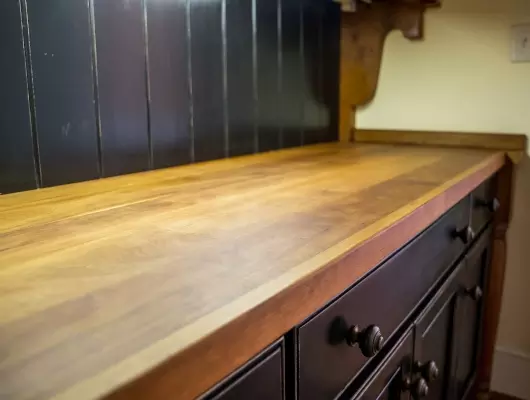
Butcher block countertops bring a whole new level of utility and flexibility to your kitchen, allowing you to prep where you please!
Butcher Block Countertop – Why It Belongs in Your Kitchen
Why waste precious counterspace when you can just cut your food on the counter itself? Butcherblock countertops allow you to prepare your food directly on their surface without having to worry about damaging them.
In this post, you will learn:
- What is a butcher block countertop?
- Types of butcher block countertops
- The benefits of butcher block countertops
- How to care for butcher block countertops
What is a Butcher Block Countertop?
A butcher block countertop is a countertop built entirely from wood with the intention of being used as a food-safe work surface. Butcher block countertops come in several different orientations, each with its own benefits and appearances.
 1.
1.
Face Grain Butcher Block Countertops
Face grain countertops feature wider planks that are laminated together in such a way that they feature more of the face grain of the wood. These are less durable than some of the alternative methods but the reason this orientation is chosen over its competitors is because of its natural beauty. Swirling grain and knotty wood can be seen in this orientation more easily than the alternatives.
 2.
2.
Edge Grain Butcher Block Countertops
Edge grain countertops are a similar orientation to face grain countertops except they make use of narrower planks that are glued together on their faces (rather than their edges). This means that the only exposed portion of each plank is the thickness of the plank, the edge grain. These countertops run along the length of the planks. It can be inferred that more work will be required to build an edge grain countertop thus warranting a higher price. On the other hand, dimensional lumber of the appropriate size is much easier to find for this option than face grain, especially if you desire thick face grain cabinets. Prices may fluctuate based on what materials you choose for your butcher block surface.
 3.
3.
End Grain Butcher Block Countertops
Lastly, end grain countertops. These countertops are by far the most durable, but they are also the most work-intensive, and for this reason, they are the most expensive option. Often, the word “Butcher Block” implies that the surface is made from the end grain, as it best aligns with people's vision of what a butcher would use. Rather than cutting and scraping across the grain of the wood, end grain cutting boards are constructed so that the knife will never really cut “against the grain” but more so “into” the grain. Picture the planks we mentioned in the edge grain countertops being cut into little chunks and then being glued back up into the same shape, just with a different orientation. It seems counterintuitive but it has its purpose. Any good woodworker knows that end grain is extremely tough. End grain is the face that is exposed when you look down at a stump. It is the direction that water flows up and down the tree. They are very porous. End grain surfaces require more maintenance and upkeep than face or edge grain, but they are also the best at hiding knife marks.
The Perks of Having Butcher Block Countertops
Butcher block countertops serve as beautiful and durable cutting surfaces that surround your kitchen. Whether it's functionality or aesthetic that you’re searching for, butcher block countertops deliver on all fronts. As mentioned previously, the most obvious benefit of butcher block countertops is the utility. Being able to cut directly on your work surface saves you the time you would have to spend pulling out your cutting board or moving things around to accommodate the space needed to prep your food. But why stop there!? Put a butcher block countertop on your kitchen island and then you have got a giant charcuterie board! It’s the perfect space to host a grab and go party! If you are not the party type, no worries, you’ve tons of extra real estate to cook food for yourself. Even the extremists who do not go near the kitchen can appreciate the beauty of a masterfully crafted wooden counter.

Short-Term Butcher Block Countertop Care
Everyday maintenance is also required to keep your surfaces clean and bacteria-free but on the bright side, this will only take a few minutes in most cases. Wiping up any loose liquids from the surface is a great way to keep your counters clean and this helps them last longer as well. Cleaning your counters with a mild detergent is safe according to most sources but use caution when getting your surfaces wet, as this sometimes forces the bacteria into the grain of the wood. Once you have cleaned the countertops, simply apply a thin layer of bee’s wax or mineral oil (or both) with a paper towel and allow it to soak in. This will protect the surface of your counters as well as sink into the grain of the wood to prevent other liquids from penetrating your worksurface.

Long-Term Butcher Block Countertop Care
Butcher block surfaces are intended to take a beating. Some handle it better than others, but all of them will require your attention each time they are used to some extent. Face grain and edge grain counters are the most likely to show knife marks or scratches. Some will see this as a mark of character while others find it unsightly. Shallow knife marks can be removed with sandpaper and a bit of elbow grease but be sure to pay close attention to the type of finish used on your countertops, as some are not fixed as easily as others. If you wish to remove deep scratches, this CAN be done with a planer in most cases, however, in some cases it is considered to be dangerous and can result in more damage than it is worth. Face grain and edge grain countertops should be able to be run through a planer or wide belt sander with few issues. End grain works differently because its fibers tend to fight against the planer. It is recommended that end grain surfaces just be sanded down to a fresh surface if you should choose to resurface them. End grain surfaces can be run through a planer with extremely thin passes, but most professionals will recommend against it and opt for sanding them.









